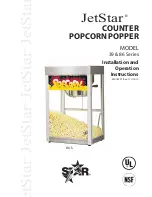
Drying Vegetables
Choose vegetables that are fresh and crisp as they will yield the best results.
PREPARATION
As with fruits, wash the vegetables and remove any blemishes or spoiled spots.
Cut into
slices or wedges.
PRETREATMENT (OPTIONAL)
As with fruits, vegetables need not be pretreated to achieve good results. Listed
below are several pretreating options. Pretreating does help retain color, extend
shelf life and enhance nutritional value.
Blanching
Blanching can be used to stop the flavor loss caused by enzymes naturally found
in vegetables. Blanching involves
a
steam of water bath. This is ideal for veg-
etables with a long cooking time such as; corn, peas, beans or other vegetables
with a tough outer skin.
Microwave
Blanching
Prepare vegetables as for regular blanching.. Place a small amount of water in a
microwave-safe, shallow cooking dish. Refer to your microwave instructions for
cooking times. Use only a quarter of the time suggested. Microwave blanching,
leaves the vegetables with a brighter color than steam-blanched vegetables.
Once blanching is complete, place immediately on trays to dry.
DRYNESS TEST
Vegetables will be hard and briffle when dried. Cool the vegetables before test-
ing for dryness. Some foods like tomatoes will be more leathery. The best test
is to feel if the vegetables appear dry enough to store.
FRUIT LEATHER/ROLLS
Puree your favorite fruit in a blender or by hand. It is not necessary to add
sugar; the roll will be naturally sweet. Pour onto the supplied plastic tray insert.
The mixture should be about
thick. The tray insert will hold about 1-2 cups
of pureed fruit. Smooth out with a spoon. Dry for about 4-8 hours. Fruit leather
is dry when it is no longer sticky to the touch. Remove from the tray when dried.
Fruit rolls will keep up to a year, properly packed at room temperature.
10
Содержание FD5
Страница 27: ...Notes ...












































